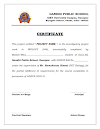CLASS-XII BIOLOGY CHAPTER END TEST
Embryo sac is to ovule as _______ is to another. (1M)
A dicotyledonous plant bears flowers but never produces fruits and seeds. The most probable cause for the above situation is: (1M)
Plant is dioecious and bears only pistillate flowers
Plant is dioecious and bears both pistillate and staminate flowers
Plant is monoecious
Plant is dioecious and bears only staminate flowers.
During microsporogenesis, meiosis occurs in: (1M)
Endothecium
Microspore mother cells
Microspore tetrads
Pollen grains.
A particular species of plant produces light, non-sticky pollen in large numbers and its stigmas are long and feathery. These modifications facilitate pollination by: (1M)
Insects
Water
Wind
Animals
What do you technically call the water that you drink and the kernel that you eat in a tender coconut? (2M)
Why is an apple called a false fruit and a banana a parthenocarpic fruit? (2M)
Explain the development of megaspore mother cells up to the formation of a mature embryo sac in angiosperms. (3M)
Pollination is an essential ecological survival function. Flower pollination is one of the crucial events in the life cycle of many flowering plants. When a pollen grain moves from the anther (male part) of a flower to the stigma (female part), pollination happens. To be pollinated, pollen must be moved from a stamen to the stigma. This is the first step in a process that produces seeds, fruits, and the next generation of plants. It may be self or cross. There are several strategies that flowering plants utilize to move pollen from one flower to another including wind, water, and animal pollination. Pollinators, like bees, form an important aspect in global economic systems and social activities and traditions. Around five to eight % of current global crop production is directly ascribed to animal pollination, which equates to somewhere between 235 and 577 billion American dollars worldwide. (4M)
Light and sticky pollen grains are features of
Wind pollinated flower
Animal pollinated flower
Insect pollinated flower
Animal pollinated flower
Assertion: All aquatic plants do not show pollination by water. Reason: some aquatic plants show insect pollination.
Both assertion and reason are correct and the reason is the correct explanation of assertion.
Both assertion and reason are correct and the reason is not a correct explanation of assertion.
Assertion is true but the reason is false
Assertion is false but the reason is true.
transfer of pollen grains from the anther to the stigma of another flower of the same plant
Autogamy
Geitonogamy
Xenogamy
Emasculation
Large flowers which are colourful, fragrant, and rich in nectar show
Insect pollination
Wind pollination
Aquatic pollination
No pollination
Answer the following : (5M)
Draw a schematic labelled diagram of a fertilized embryo sac of an angiosperm.
Describe the stages in embryo development in a dicot plant.













0 Comments